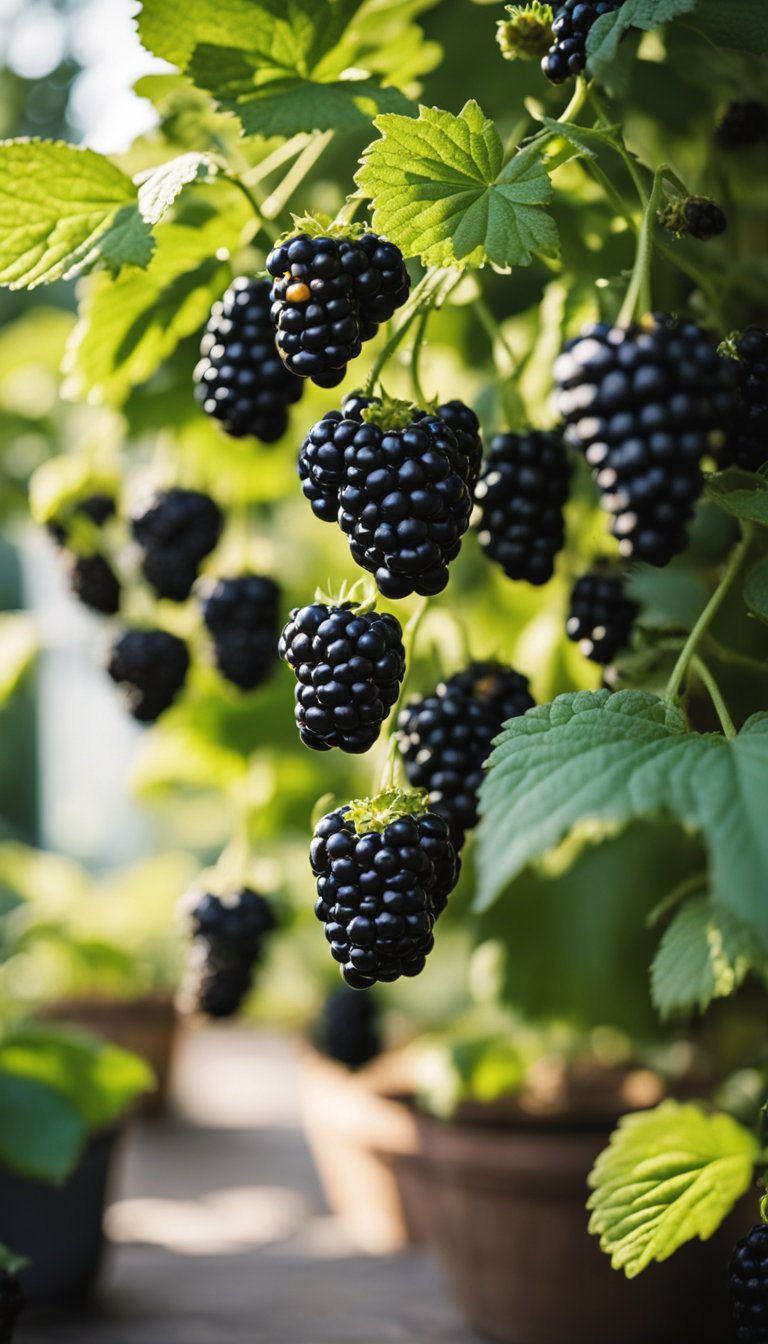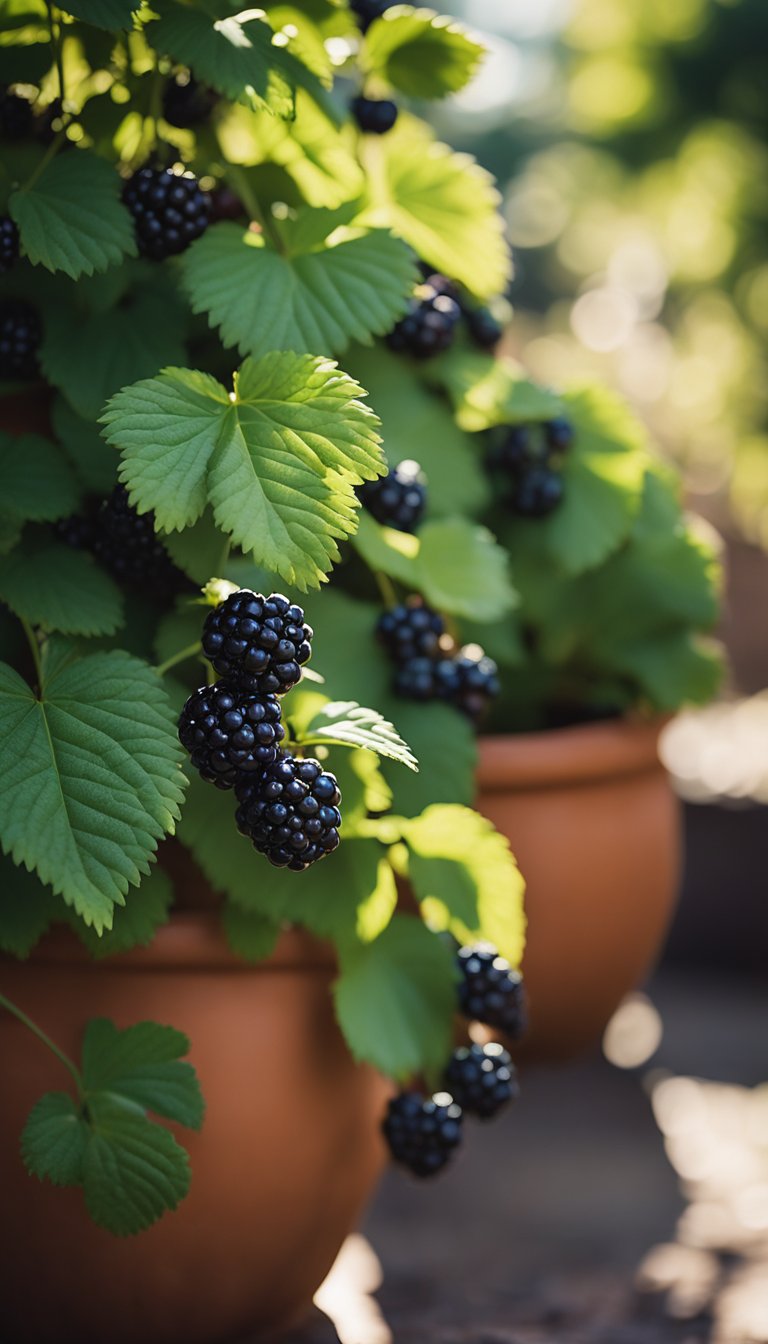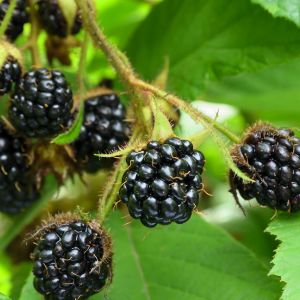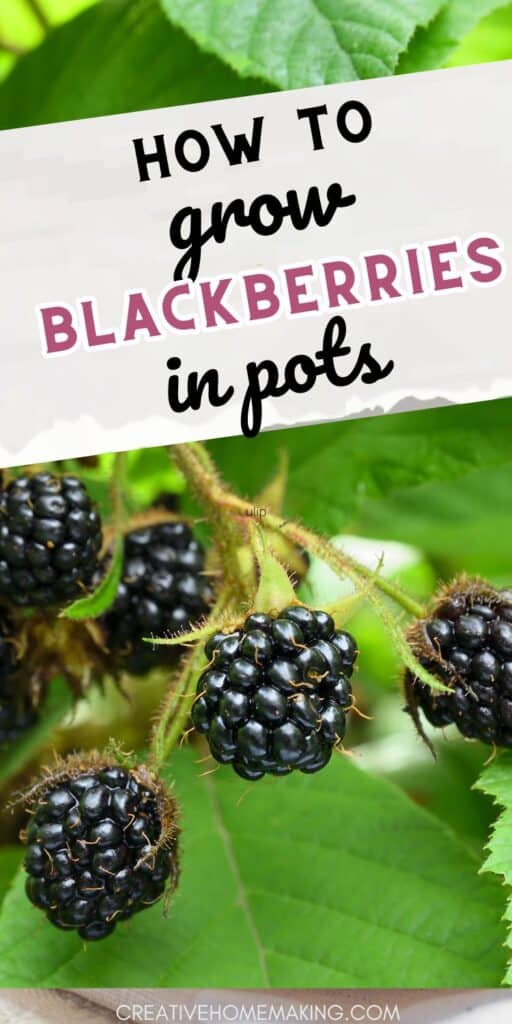Growing blackberries in pots is a great option for those with limited garden space or for those who want to keep their blackberry plants contained.
This post may contain affiliate links.
With the right care and attention, you can grow delicious blackberries right on your balcony or patio. In this article, we will provide you with all the information you need to successfully grow blackberries in pots.
First, we will discuss the best types of blackberry plants to grow in pots and the ideal pot size and soil type to use. We will also cover the importance of providing your blackberry plants with the right amount of sunlight, water, and fertilizer.
Additionally, we will provide tips on how to prune and train your blackberry plants to ensure they stay healthy and productive.
By the end of this article, you will have all the knowledge you need to grow your own blackberries in pots and enjoy the sweet taste of fresh, homegrown fruit. So, let’s get started and learn how to grow blackberries in pots!
Related Article: Planting Blackberries: Tips for a Successful Harvest
Choosing the Right Containers
When it comes to growing blackberries in pots, choosing the right container is crucial for the success of your plants. Here are some things to consider when selecting the perfect pot.
Pot Size and Material
Blackberry plants need enough room to grow, so it’s important to choose a container that is at least 5 gallons in size. The pot should also be made of a durable material, such as plastic or ceramic, that can withstand the elements.
Related Article: How to Grow Blueberries in Pots
Importance of Drainage Holes
Proper drainage is essential for the health of your blackberry plants. Make sure your container has drainage holes to prevent water from accumulating at the bottom of the pot. This can cause root rot and other issues that can harm your plants.
When selecting containers, keep in mind that blackberry plants can be quite heavy once they are fully grown. Make sure your pots are sturdy and can support the weight of the plants.
With the right containers, you can enjoy fresh blackberries right from your own patio or balcony!
Selecting Soil and Fertilizer
When it comes to growing blackberries in pots, selecting the right soil and fertilizer is crucial for the plant’s growth and fruit production. In this section, we’ll cover the basics of selecting soil and fertilizer for your blackberry plants.
Potting Soil Mix
Using the right potting soil mix is essential for the healthy growth of blackberry plants. A good potting soil mix should be well-draining and have a pH level between 5.5 and 6.5.
You can purchase a pre-mixed potting soil or make your own by mixing equal parts of peat moss, perlite, and vermiculite.
When selecting a potting soil mix, make sure it is labeled as suitable for container gardening. Avoid using garden soil as it is too heavy and can retain too much moisture, which can lead to root rot.
Related Article: Growing Lemon Balm in Pots
Fertilizer Types and Application
Blackberry plants require regular fertilization to produce healthy foliage and fruit. There are two types of fertilizer that you can use: organic and synthetic.
Organic fertilizers, such as compost and manure, are a great option for those who prefer natural methods. They release nutrients gradually and improve soil structure. Apply organic fertilizers to the soil surface and mix them in lightly.

Synthetic fertilizers, on the other hand, provide a quick boost of nutrients. They are available in granular or liquid form. Follow the manufacturer’s instructions for application rates and timing.
In general, blackberry plants should be fertilized three times a year: in early spring, after the first harvest, and in late summer. Avoid fertilizing when the plant is flowering as it can lead to excessive vegetative growth and reduced fruit production.
In addition to fertilizer, you can also use mulch to help retain moisture and suppress weeds. Apply a layer of mulch around the base of the plant, but avoid covering the stem.
Related Article: Growing Grapes in Pots: Tips and Tricks for Successful Container Gardening
Planting and Propagation
When to Plant
Blackberries can be planted in early spring or late fall. If you are planting in a pot, it is best to do so in early spring when the weather is mild and the soil is starting to warm up. This will give your blackberry plant the best chance of success.
Propagation Techniques
There are two main ways to propagate blackberries: by seeds and stem cuttings. If you are starting from seeds, it is best to sow them in early spring in a seed tray filled with compost.
Keep the tray in a warm, bright location and water regularly. Once the seeds have germinated, you can transplant them into individual pots.
Stem cuttings are a quicker and more reliable way to propagate blackberries. Take a stem cutting from a healthy plant in early spring or late fall. The cutting should be around 6 inches long and have at least two nodes.
Remove the leaves from the bottom half of the stem and dip it in rooting hormone. Plant the stem cutting in a pot filled with compost and keep it in a warm, bright location. In a few weeks, roots should start to form and your new blackberry plant will be ready to grow.
Related Article: Best Soil for Strawberries in Pots
When planting blackberries in pots, make sure to use a good quality potting mix that is rich in nutrients and well-draining. Plant the blackberry in the center of the pot and make sure the roots are covered with soil.
Water the plant regularly and make sure the soil stays moist but not waterlogged. With proper care and attention, your blackberry plant will thrive and produce delicious fruit for years to come.

Sunlight and Temperature Requirements
Finding the Perfect Spot
When growing blackberries in pots, it is important to find the perfect spot with adequate sunlight and temperature. Blackberries require full sun exposure to thrive, so make sure to place your pots in an area that receives at least 6 hours of direct sunlight per day.
If you live in a hot climate, you may want to consider providing some shade during the hottest parts of the day to prevent the plants from getting too stressed.
Understanding Hardiness Zones
Another important factor to consider when growing blackberries in pots is the hardiness zone of your area. Blackberries are typically hardy in zones 5-9, but some varieties can tolerate colder or warmer climates.
You can check your USDA hardiness zone to determine which varieties will thrive in your area.
Related Article: Growing Hydrangeas in Pots
In addition to sunlight and hardiness zones, temperature is also an important factor to consider. Blackberries prefer moderate temperatures between 60-85°F.
If temperatures get too hot or too cold, it can negatively impact the growth and fruit production of your plants. To ensure optimal growth, try to maintain a consistent temperature range in the area where your pots are located.
By finding the perfect spot with adequate sunlight and temperature, you can ensure that your blackberry plants thrive and produce delicious fruit.
Watering and Drainage
Watering Schedule
When growing blackberries in pots, it is important to water them regularly. Depending on the weather conditions, you may need to water your blackberries every day or every other day. The key is to keep the soil evenly moist, but not waterlogged.
To determine if your blackberries need watering, check the soil with your finger. If it feels dry to the touch, it’s time to water. Be sure to water deeply, so the water reaches the roots of the plant.
Related Article: Growing Clematis in Pots
Ensuring Proper Drainage
Good drainage is essential for growing blackberries in pots. Without proper drainage, the roots can become waterlogged and the plant can suffer. To ensure good drainage, make sure your pot has drainage holes in the bottom.
When watering your blackberries, be sure to water slowly and evenly. This will allow the water to soak into the soil and drain out the bottom of the pot. If you notice water pooling on the surface of the soil, you may be watering too quickly.
If you are concerned about drainage, you can add a layer of gravel or small stones to the bottom of your pot before adding soil. This will help to improve drainage and prevent water from pooling in the bottom of the pot.
Support and Pruning
Setting Up a Trellis
When growing blackberries in pots, it is important to provide them with proper support. A trellis is an excellent way to keep your blackberry plants upright and healthy.
You can easily set up a trellis by attaching it to the sides of your pots or using a stake in the center of the pot. Make sure to use a sturdy trellis that can support the weight of the blackberry canes.
Pruning Techniques
Pruning is an essential part of growing blackberries in pots. It helps to keep the plants healthy and productive. Prune your blackberry plants in late winter or early spring before new growth appears.
Remove any dead, damaged, or diseased canes and cut back the remaining canes to about 3-4 feet tall. This will help to promote new growth and increase fruit production.
During the growing season, monitor your blackberry plants for new canes. These canes will grow from the base of the plant and should be tied to the trellis or stake as they grow.
It is important to keep the canes separated and spaced out to allow for good air circulation and sunlight penetration.
In addition to pruning the canes, it is also important to remove any suckers that grow from the base of the plant.
These suckers will take energy away from the main plant and can reduce fruit production. Use a sharp pair of pruning shears to cut the suckers off at the base.
By providing your blackberry plants with proper support and using effective pruning techniques, you can enjoy a bountiful harvest of delicious blackberries from your pots.
Pest and Disease Management
Common Pests
Blackberries grown in pots are susceptible to a few common pests that can damage the plant and reduce yields. One of the most common pests is the spotted wing drosophila, a small fruit fly that lays its eggs in the fruit.
To prevent infestations, cover your plants with a fine mesh netting and harvest your berries as soon as they ripen.
Another common pest is the raspberry cane borer, which can cause wilting and death of the canes. To prevent this, inspect your plants regularly and remove any infested canes. You can also apply insecticidal soap or neem oil to control the pests.
Disease Prevention
Diseases can also be a problem for blackberries grown in pots. One of the most common diseases is anthracnose, which causes dark spots on the leaves and canes.
To prevent this, avoid overhead watering and keep the soil around the plant free of debris. You can also apply a fungicide to control the disease.
Another common disease is powdery mildew, which causes a white powdery coating on the leaves. To prevent this, provide good air circulation around your plants and avoid overcrowding them. You can also apply a fungicide to control the disease.
By taking these simple steps, you can prevent pests and diseases from damaging your blackberry plants and enjoy a bountiful harvest of delicious, juicy berries.
Harvesting and Maintenance
Harvesting Tips
When it comes to harvesting your blackberries, timing is everything. You’ll want to wait until the fruit is fully ripe before picking it. This will ensure that the berries are sweet and juicy. Blackberries typically ripen in the summer or fall, depending on the variety.
To harvest your blackberries, simply grasp the fruit gently and pull it off the plant. Be careful not to squeeze the berries too hard or they could become damaged. If you’re having trouble reaching the fruit, consider using a pair of pruning shears to snip the stem.
One important tip to keep in mind is to harvest your blackberries frequently. This will encourage the plant to produce more fruit. It’s also a good idea to pick your blackberries in the morning, when the fruit is cool and firm.
Ongoing Care and Maintenance
To ensure that your blackberry plant stays healthy and productive, there are a few things you’ll need to do on an ongoing basis. First, make sure that your plant is getting enough water. Blackberries need about 1 inch of water per week, either from rainfall or from a watering system.
You’ll also want to fertilize your blackberry plant regularly. Use a balanced fertilizer that contains nitrogen, phosphorus, and potassium. Apply the fertilizer in the spring and again in the summer.
Another important aspect of blackberry maintenance is pruning. Prune your plant in the late winter or early spring to remove any dead or damaged canes. This will encourage new growth and help your plant produce more fruit.
Finally, be sure to keep an eye out for pests and diseases. Some common blackberry pests include spider mites, aphids, and fruit flies. If you notice any signs of infestation, take action immediately to prevent the problem from spreading.
Frequently Asked Questions
What type of soil is best for growing blackberries in containers?
Blackberries thrive in well-draining soil that is rich in organic matter. You can use a potting mix specifically formulated for container gardening or make your own by mixing equal parts of peat moss, compost, and perlite.
How do you grow blackberries from cuttings in pots?
To grow blackberries from cuttings, take a 6-inch cutting from the tip of a healthy stem in late spring or early summer. Remove the bottom leaves and dip the cut end in rooting hormone powder.
Plant the cutting in a pot filled with moist potting mix and keep it in a warm, bright location. The cutting should root in about 4-6 weeks.
What size container is ideal for a blackberry bush?
A container that is at least 18 inches in diameter and 20 inches deep is ideal for growing a blackberry bush. This size will provide enough space for the roots to grow and the plant to produce a good crop of berries.
How should blackberries in pots be cared for during winter?
In winter, blackberry plants in pots should be moved to a sheltered location, such as a garage or shed, where the temperature stays above freezing.
Water the plants sparingly and prune them back to about 12 inches in height. In spring, move the plants back outside and resume regular watering and fertilizing.
Can you grow blackberries in pots from seeds, and if so, how?
Yes, you can grow blackberries in pots from seeds, but it is not the recommended method as blackberry seeds have a low germination rate.
To grow blackberries from seeds, sow them in a pot filled with moist potting mix in early spring. Keep the pot in a warm, bright location and water it regularly. The seeds should germinate in about 2-3 weeks.
Do blackberry plants in containers require a trellis for support?
Yes, blackberry plants in containers require a trellis for support. You can use a bamboo stake or a wire trellis to support the plant as it grows. Tie the canes to the trellis with garden twine to keep them upright and prevent them from breaking under the weight of the berries.
Follow my gardening board on Pinterest.



